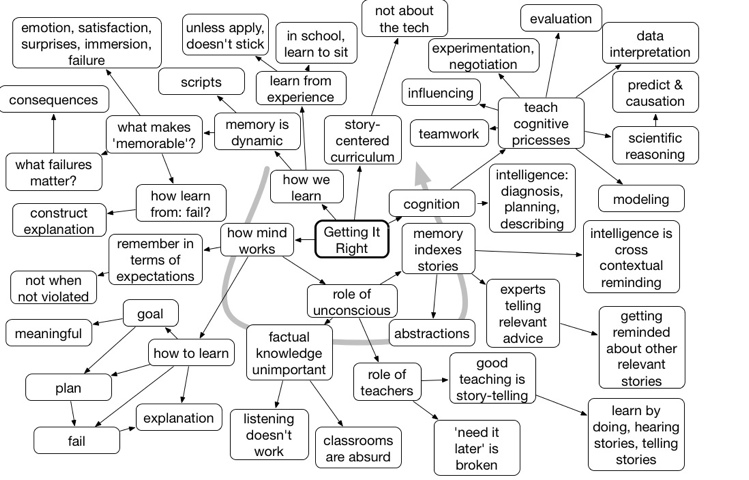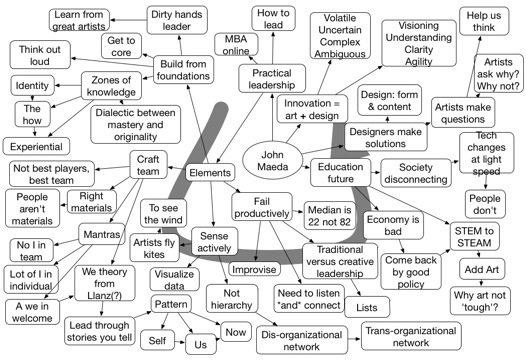Today, Roger Schank keynoted the Learning Technologies UK conference, talking about cognitive science and learning. Obviously, I was in large agreement. And, as usual, I mid mapped it:
Search Results for: mindmap keynote
Alan Kay keynote mindmap from #iel2010
Zimmerman Keynote Mindmap DevLearn 09
Eric Zimmerman spoke eloquently on games as the second day keynote at DevLearn. In it, he talked about how systems thinking was important, how games are systems of rules and consequently develop systems thinking. He talked about how our play brings meaning to the rules, and that creating spaces of possible outcomes allow us to explore.
He ended up advocating that we design for possibilities of unexpected outcomes to create meaning for our learners. Cammy Bean has blogged the presentation too.
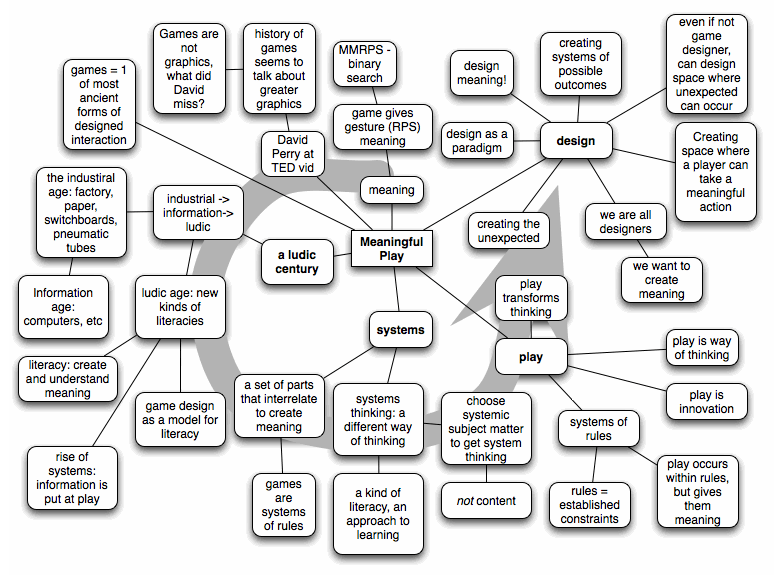
Mindmapping
So, if you haven’t figured it out yet, I do mindmaps. As I’ve recited before, I started doing it as a way to occupy my brain enough so I could listen to keynotes, but occasionally I use it to other purposes, such as representing structure or even planning. And thru my esteemed colleague Jane Hart (who’s Modern Workplace Learning book I’m going through and thoroughly impressed), I’m giving a mindmapping webinar today for a group of several universities in Ireland. I thought I’d share what I’m presenting.
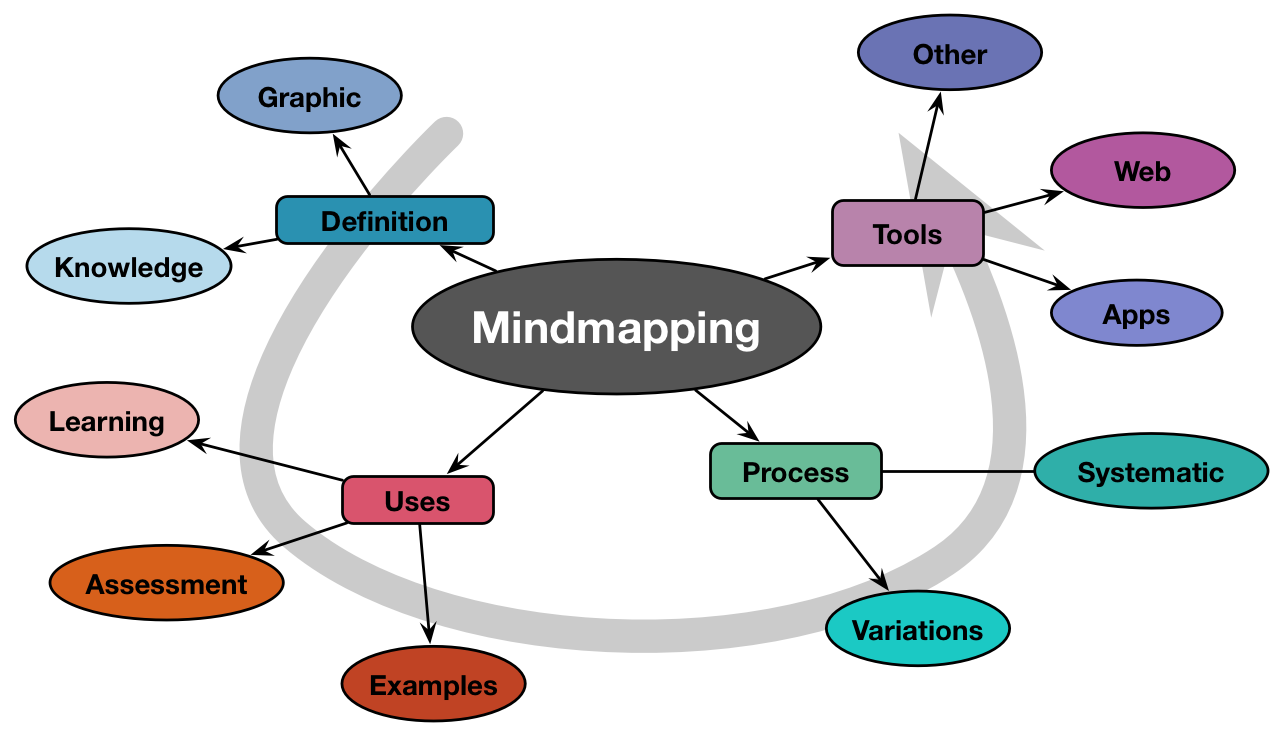 Mindmaps are a visual way of representing knowledge. You use links to show connections between concepts (represented as nodes), developing a structural relationship. A true semantic network would have those links labeled, as there are many different types of relationships (causal, precedence, hierarchical), but mindmaps typically have unlabeled links. Still, mindmaps capture structural information in a visual way, that supports tapping into our powerful visual processing system. (This is the one I created for them to advertise the talk, it’s neither the order I ended up for them or am using here. ;)
Mindmaps are a visual way of representing knowledge. You use links to show connections between concepts (represented as nodes), developing a structural relationship. A true semantic network would have those links labeled, as there are many different types of relationships (causal, precedence, hierarchical), but mindmaps typically have unlabeled links. Still, mindmaps capture structural information in a visual way, that supports tapping into our powerful visual processing system. (This is the one I created for them to advertise the talk, it’s neither the order I ended up for them or am using here. ;)
You can add information to them; as a visual tool, you can add extra graphical information, like tables or charts, to augment the map. You can similarly add color as a way to layer additional semantic information such as similarity. And the links can be plain or directional. Importantly, while a mindmap can be essentially equivalent to an outline if you maintain a strict tree structure, you can create a graph by having more complex links that generate loops.
The process of mindmapping is fairly straightforward: you have a central node, and then generate additional nodes and link them. I tend to go counter-clockwise, and include an arrow indicating that, because I’m capturing a linear presentation, but generating a static representation of information doesn’t have any directional requirement. I find that I have to frequently rearrange to fit the mindmap appropriately to the image, but that’s part of the benefit.
The evidence appears to show that mindmapping is superior to note-taking. I don’t do it all the time, but there are reasons to think you should. The reasons, I believe, that it is better is that you’re not just transcribing a presentation, but you’re actively parsing it to represent the structure. If you do take notes, you should be paraphrasing what you hear in your own words, to have active processing of the information. The additional effort to extract the structure as well is a form of valuable cognitive processing that elaborates the information. Doing both, paraphrasing and extracting structure, would be a great way to really comprehend what you’re hearing.
As suggested, it’s helpful to mindmap talks, but it can also be a thinking tool, to analyze situations and sort out your thoughts or plan activities and add elements as you think of them. No real advantage over an outline, potentially (though the ability to add other graphics and to make non-strict maps may counter that), though I suspect some find the drawing and rearranging to be a nice physical overhead to facilitate reflecting. And, of course, it can be an evaluation tool, asking someone to create their maps to see their understanding.
While there are dedicated tools for mindmapping, both applications and in the cloud, which will make creating and rearranging easier (I presume), you can use almost any drawing package (I use OmniGraffle). You could use Powerpoint or Keynote, and even pencil and paper (if it’s just for the processing) though it can be harder to revise.
So, that’s my riff on mind mapping. I welcome your thoughts.
John Maeda #LSCon Mindmap
Who are mindmaps for?
In response to my recent mindmap of Andrew McAfee’s conference keynote (one of a number of mindmaps I’ve done), I got this comment:
Does the diagram work as a useful way of encapsulating the talk for someone who was there? Because, speaking as someone who wasn‘t, I find it almost entirely content-free. Just kind of a collection of buzz-phrases in thought bubbles, more or less randomly connected.
I‘m not trying to criticise his talk – which obviously I didn‘t hear – or his points – which I still have no idea about – but the diagram as a method of conveying information is a total failure to this sample size of one. Possibly more useful as a refresher mechanism for people who got the talk in its original form?
Do mindmaps work for readers? Well, I have to admit one reason I mindmap is completely personal. I do it to help me process the presentation. Depending on the speaker, I can thoughtfully reprocess the information, or sometimes just take down interesting comments, but there are several benefits: In figuring out the ways to link, I’m capturing the conceptual structure of the talk (really, they’re concept maps), and I’m also occupying my personal bandwidth enough to allow me to focus on the talk without my mind chasing down one path and missing something. Er, mostly…
Then, for a second category, those who actually heard the talk, they might be worthwhile reflection and re-processing. I’d welcome anyone weighing in on that. I don’t have access to someone else’s example to see whether it would work for me.
Then, there are the potential viewers, like the commenter, for whom it’s either possible or not to process any coherent idea out of the presentation. I looked back at the diagram for McAfee’s keynote, and I can see that I was cryptic, missing some keywords in communicating. This was for two reasons: one, he was quick, and it was hard to get it down before he’d moved on. Two, he was eloquent, and because he was quick I couldn’t find time to paraphrase. And there’s a more pragmatic reason; I try to constrain the size of the mindmap, and I’m always rearranging to get it to fit on one page. That effort may keep me more terse than is optimal for unsupported processing.
I will take issue with “more or less randomly connected”, however. The connections are quite specific. In all the talks I’ve done this for, there have been several core points that are elaborated, in various ways by talk, but each talk tends to be composed of a replicated structure. The connections capture that structure. For instance, McAfee repeatedly took a theme, used an example to highlight it, then derived a takehome point and some corollaries. There would be ways to more eloquently convey that structure (e.g. labeled links, color coding), but the structure isn’t always laid out beforehand (it’s emergent), and is moving fast enough that I couldn’t do it on the fly.
I could post-process more, but in the most recent two cases I wanted to get it up quickly: when I tweeted I was making the mindmap, others said they were eager to see it, so I hung on for some minutes after the keynotes to get it up quickly. McAfee himself tweeted “dang, that was FAST – nice work!”
I did put the arrow in the background to guide the order in which the discussion came, as well, but apparently it is too telegraphic for the non-attendee. It happens I know the commenter well, and he’s a very smart guy, so if he’s having trouble, that’s definitely an argument that the raw mindmap alone is not communicative, at least not without perhaps some post-processing to make the points clear.
Really valuable to get the feedback, and worthwhile to reflect on what the tradeoffs are and who benefits. It may be that these are only valuable for fellow attendees. Or just me. I may have to consider a) not posting, b) slowing down and doing more post-processing, or…? Comments welcome!
McAfee Keynote at DevLearn 2009
Andy McAfee gave us a lively and informative presentation on his view of Enterprise 2.0. Punctuated by insightful examples, he defined Enterprise 2.0 as “”use of emergent social software platforms by organizations in pursuit of their goals”, and characterized it more simply as ‘bringing web energy into organizations’.
Along the way, he emphasized points about emergent behavior, inherent altruism, emergent process, developing innovation, the intelligence of crowds, and real business benefits. A 20% improvement in innovation was one concrete result. He also warned us of the ways to snatch victory from the jaws of defeat.
BTW, Cammy Bean’s has posted a prose recitation of the talk. With no further ado:
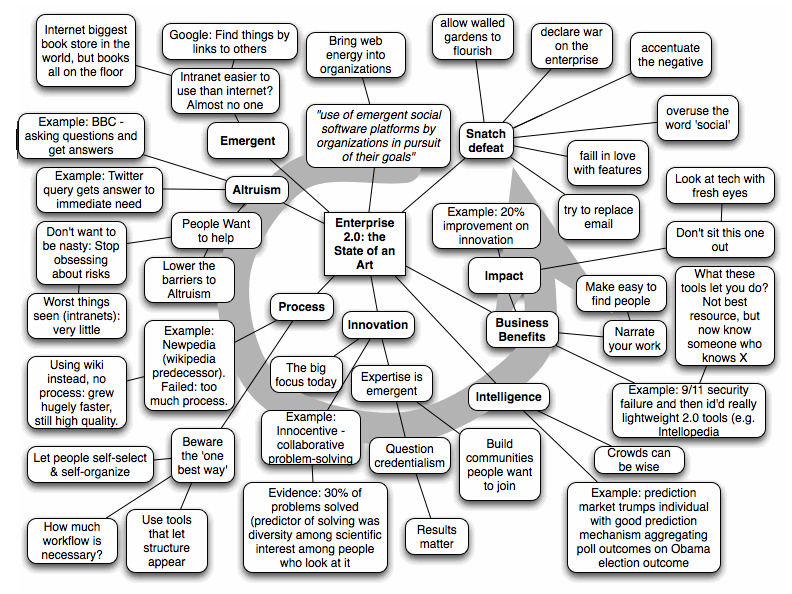
Guild Keynote: Stefan Sagmeister
Stefan Sagmeister’s a renowned designer, and gave us a talk about what he’s learned and how it’s influenced his design. Or rather, more how what he’s learned has driven a number of design projects. He started with the type of stuff his studio does: music business design (a music building flexible logo approach), socially responsible design (helping TrueMajority.org demonstrate Pentagon spending in context, with creative approaches including the pig car train and the topsy-turvy bus), and corporate design (an embossed organic hierarchy, e.g. flowers, as a vehicle for different lighting treatments to illustrate a lighting company corporate report).
The second part of his talk started with talking about how creative organizations use reflection to maintain innovation. This was an interesting contrast to a discussion in the first day of the Learning Management Colloquium where Lance was arguing with a audience member about whether reflection was necessary (!?!). Obviously, I’m all for it; in times of increasing change, execution of established patterns won’t help, and you’ll need to innovate, and reflection is a component of that.
From his reflections, he had a list of statements or mantras that he then had used as the basis for a number of commissioned works with a wide variety of representations, from words created out of a variety of materials to huge manifestations of the prose. There was quite a variety, some of them seeming to overlap a bit in the content of the phrases, and sometimes in the approach taken. Some were very clever plays, however, on the concepts. A billboard that faded illustrated letting go of issues, and a visual web that you got ‘tangled in’ as you passed by reflected the problems of lying.
Not specifically about learning, the issues of creativity and reflection were valuable and inspirational. My last mind map, at least for this conference:
eLearning Guild Keynote: John Patrick
Today’s keynote was John Patrick, talking about the future of the internet and implications for learning. There was a lot of the former, and unfortunately not enough of the latter. He made some great points, specifically that we’re only tapping 5% of the potential, citing a number of examples of where people were dropping the ball (what a great deal, getting paid to whinge about bad internet experiences :), and also about what was possible with coming developments. Here’s the mindmap:
In followup questions (part of the learning management colloquium), he talked a bit more about learning to learn (a pet fave of mine): that, generationally-independently, some get it and some don’t. I asked the obvious question: given that the internet has so much knowledge, but (as he claimed in his talk) that folks don’t necessarily have good internet skills, would the obvious implication be that the role of formal learning be about how to learn to learn with internet resources? His answer was discursive, unfortunately, but an interesting opportunity would be a software ‘net-surfing’ coach that watched your net strategy and provided guidance.
The opportunities of ubiquitous internet access are exciting, certainly, but I think it will take some smart ‘voting with eyeballs’ to really make a change. I’m an idealist, but I also recognize that individuals are satisficing, not optimizing, and people are still buying shoddy product (why are people still buying Coors?). How will we get the necessary cluetrain going? Odd thought: ridicule.
eLearning Guild Keynote: Keith Sawyer
Today I’m at the eLearning Guild’s Annual Gathering. Yesterday I was part of two different pre-conference symposiums, one on Immersive Learning Simulations (read: serious games) and Mobile Learning, and today we started off with a keynote. I mind-mapped it, which I sometimes do, and here’s the result:
Overall, I confess I was a wee bit underwhelmed, as some of the talk was that a constructivist approach fostered more innovative folks. Well, yeah. However, there were some good points, and he told a great story about the real history of Monopoly.
The main good point was debunking the myth that innovation is individual insight, and his research on creativity shows how teams iterate over time to create new ideas. He also pointed out a couple of ways to facilitate creativity, which included building layouts (pointing to his book, ahem), and re-assigning staff as a systematic organizational policy.
There were also some good details about making effective learning (see the subtrees from the ‘challenges’ node in the mind map, above), including identifying a relevant problem, supporting active learning, fostering effective collaboration, and creating shared artifacts. Most specifically, the details underneath these were more depth than you often get.
Of course, the question is whether the talk was relevant for the general audience, not me (after all, I too have studied creativity, and the learning sciences). My informal poll seemed to support my view, but the eLearning Guild is making some good efforts at linking in social tools, so there should be lots of reactions being tracked. Did you see his presentation? If so, what did you think?
